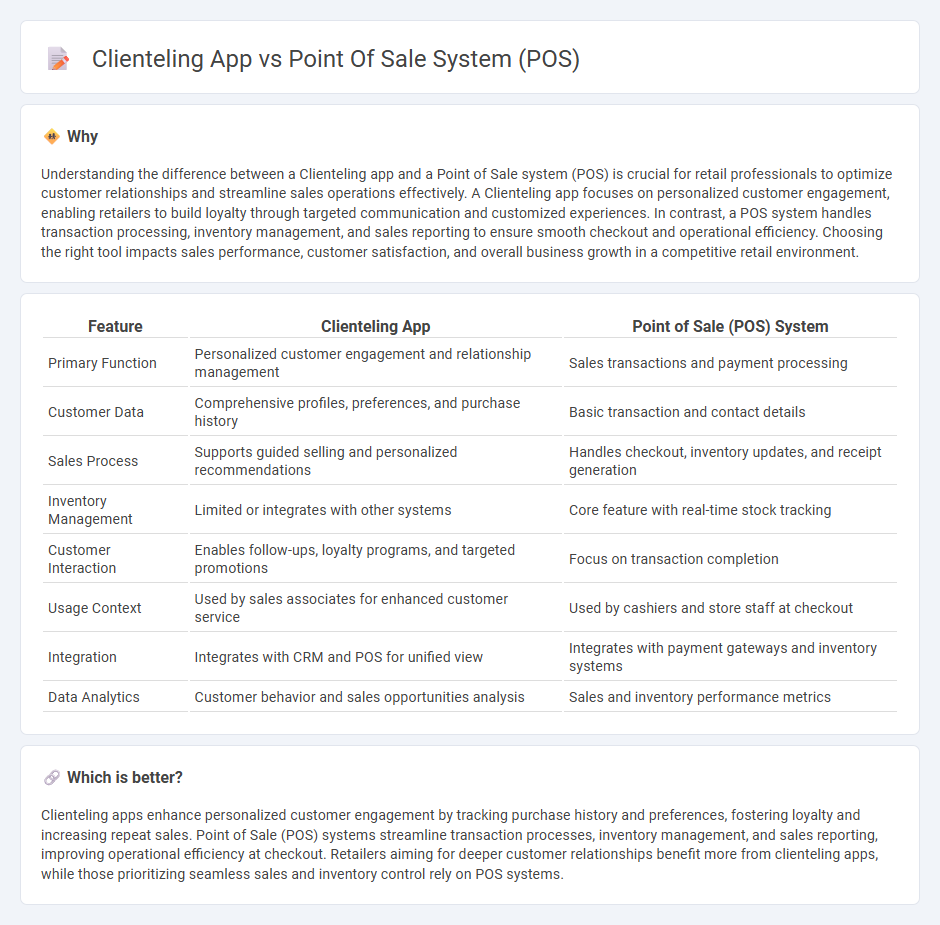
Clienteling apps enhance customer relationships by providing personalized shopping experiences based on detailed purchase history and preferences, while Point of Sale (POS) systems focus on efficient transaction processing and inventory management. These technologies collectively improve retail operations by blending customer engagement with streamlined sales workflows. Discover how integrating clienteling apps with POS systems can transform your retail strategy.
Why it is important
Understanding the difference between a Clienteling app and a Point of Sale system (POS) is crucial for retail professionals to optimize customer relationships and streamline sales operations effectively. A Clienteling app focuses on personalized customer engagement, enabling retailers to build loyalty through targeted communication and customized experiences. In contrast, a POS system handles transaction processing, inventory management, and sales reporting to ensure smooth checkout and operational efficiency. Choosing the right tool impacts sales performance, customer satisfaction, and overall business growth in a competitive retail environment.
Comparison Table
| Feature | Clienteling App | Point of Sale (POS) System |
|---|---|---|
| Primary Function | Personalized customer engagement and relationship management | Sales transactions and payment processing |
| Customer Data | Comprehensive profiles, preferences, and purchase history | Basic transaction and contact details |
| Sales Process | Supports guided selling and personalized recommendations | Handles checkout, inventory updates, and receipt generation |
| Inventory Management | Limited or integrates with other systems | Core feature with real-time stock tracking |
| Customer Interaction | Enables follow-ups, loyalty programs, and targeted promotions | Focus on transaction completion |
| Usage Context | Used by sales associates for enhanced customer service | Used by cashiers and store staff at checkout |
| Integration | Integrates with CRM and POS for unified view | Integrates with payment gateways and inventory systems |
| Data Analytics | Customer behavior and sales opportunities analysis | Sales and inventory performance metrics |
Which is better?
Clienteling apps enhance personalized customer engagement by tracking purchase history and preferences, fostering loyalty and increasing repeat sales. Point of Sale (POS) systems streamline transaction processes, inventory management, and sales reporting, improving operational efficiency at checkout. Retailers aiming for deeper customer relationships benefit more from clienteling apps, while those prioritizing seamless sales and inventory control rely on POS systems.
Connection
Clienteling apps and Point of Sale (POS) systems are integrated to enhance personalized customer experiences by synchronizing purchase history, preferences, and real-time inventory data. This connection allows sales associates to access detailed customer profiles during transactions, enabling targeted recommendations and efficient service. The seamless data exchange between clienteling software and POS streamlines sales processes, increases customer loyalty, and boosts overall retail revenue.
Key Terms
Source and External Links
What Is a Point-of-Sale (POS) System? - U.S. Chamber of Commerce - A POS system is an electronic solution that streamlines checkout by processing payments, recording customer loyalty points, updating inventory, and replacing traditional cash registers, offered as hardware and software often cloud-based for physical stores and e-commerce businesses.
Point-of-sale (POS) systems explained: A guide for businesses - Stripe - POS systems combine hardware and software to process transactions, manage inventory, handle payments via connection to gateways, collect sales and customer data, and integrate with other business tools like accounting and CRM software.
What is a Point of Sale System? - Manhattan Associates - POS systems help businesses manage sales, inventory, customer information, gift cards, promotions, and omnichannel checkout, improving customer experience and enabling informed decisions through unified dashboards and real-time inventory updates.
 dowidth.com
dowidth.com